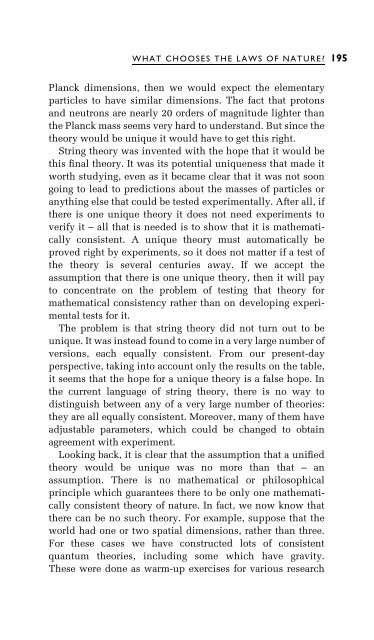Three Roads To Quantum Gravity
Three Roads To Quantum Gravity
Three Roads To Quantum Gravity
Create successful ePaper yourself
Turn your PDF publications into a flip-book with our unique Google optimized e-Paper software.
WHAT CHOOSES THE LAWS OF NATURE?<br />
195<br />
Planck dimensions, then we would expect the elementary<br />
particles to have similar dimensions. The fact that protons<br />
and neutrons are nearly 20 orders of magnitude lighter than<br />
the Planck mass seems very hard to understand. But since the<br />
theory would be unique it would have to get this right.<br />
String theory was invented with the hope that it would be<br />
this ®nal theory. It was its potential uniqueness that made it<br />
worth studying, even as it became clear that it was not soon<br />
going to lead to predictions about the masses of particles or<br />
anything else that could be tested experimentally. After all, if<br />
there is one unique theory it does not need experiments to<br />
verify it ± all that is needed is to show that it is mathematically<br />
consistent. A unique theory must automatically be<br />
proved right by experiments, so it does not matter if a test of<br />
the theory is several centuries away. If we accept the<br />
assumption that there is one unique theory, then it will pay<br />
to concentrate on the problem of testing that theory for<br />
mathematical consistency rather than on developing experimental<br />
tests for it.<br />
The problem is that string theory did not turn out to be<br />
unique. It was instead found to come in a very large number of<br />
versions, each equally consistent. From our present-day<br />
perspective, taking into account only the results on the table,<br />
it seems that the hope for a unique theory is a false hope. In<br />
the current language of string theory, there is no way to<br />
distinguish between any of a very large number of theories:<br />
they are all equally consistent. Moreover, many of them have<br />
adjustable parameters, which could be changed to obtain<br />
agreement with experiment.<br />
Looking back, it is clear that the assumption that a uni®ed<br />
theory would be unique was no more than that ± an<br />
assumption. There is no mathematical or philosophical<br />
principle which guarantees there to be only one mathematically<br />
consistent theory of nature. In fact, we now know that<br />
there can be no such theory. For example, suppose that the<br />
world had one or two spatial dimensions, rather than three.<br />
For these cases we have constructed lots of consistent<br />
quantum theories, including some which have gravity.<br />
These were done as warm-up exercises for various research



![arXiv:1001.0993v1 [hep-ph] 6 Jan 2010](https://img.yumpu.com/51282177/1/190x245/arxiv10010993v1-hep-ph-6-jan-2010.jpg?quality=85)


![arXiv:1008.3907v2 [astro-ph.CO] 1 Nov 2011](https://img.yumpu.com/48909562/1/190x245/arxiv10083907v2-astro-phco-1-nov-2011.jpg?quality=85)








![arXiv:1002.4928v1 [gr-qc] 26 Feb 2010](https://img.yumpu.com/41209516/1/190x245/arxiv10024928v1-gr-qc-26-feb-2010.jpg?quality=85)
![arXiv:1206.2653v1 [astro-ph.CO] 12 Jun 2012](https://img.yumpu.com/39510078/1/190x245/arxiv12062653v1-astro-phco-12-jun-2012.jpg?quality=85)
